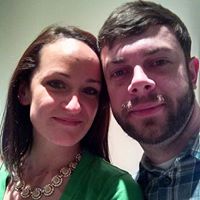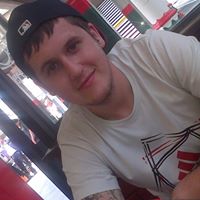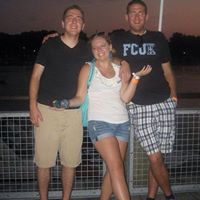Zachary K Keane
age ~43
from Baltimore, MD
- Also known as:
-
- Zachery Keane
- Phone and address:
- 219 W Lafayette Ave, Baltimore, MD 21217
Zachary Keane Phones & Addresses
- 219 W Lafayette Ave, Baltimore, MD 21217
- Silver Spring, MD
- 3706 Gainsboro Dr, Greensboro, NC 27410 • 336 288-6338
- Houston, TX
- Hanover, NH
Us Patents
-
Nanostructures And Lithographic Method For Producing Highly Sensitive Substrates For Surface-Enhanced Spectroscopy
view source -
US Patent:20120154800, Jun 21, 2012
-
Filed:Feb 12, 2008
-
Appl. No.:12/029631
-
Inventors:Douglas Natelson - Houston TX, US
Daniel Robert Ward - Houston TX, US
Zachary Kyle Keane - Houston TX, US -
International Classification:G01J 3/44
G03F 7/00
B82Y 40/00 -
US Classification:356301, 430319, 430296, 430318, 430 30, 977901
-
Abstract:A method for producing planar extended electrodes with nanoscale spacings that exhibit very large SERS signals, with each nanoscale gap having one well-defined hot spot. The resulting highly sensitive substrate has extended metal electrodes separated by a nanoscale gap. The electrodes act as optical antennas to enhance dramatically the local electromagnetic field for purposes of spectroscopy or nonlinear optics. SERS response is consistent with a very small number of molecules in the hotspot, showing blinking and wandering of Raman lines. Sensitivity is sufficiently high that SERS from physisorbed atmospheric contaminants may be detected after minutes of exposure to ambient conditions.
-
Capacitively-Driven Tunable Coupling
view source -
US Patent:20210359666, Nov 18, 2021
-
Filed:Jul 23, 2021
-
Appl. No.:17/383779
-
Inventors:Zachary Kyle Keane - Baltimore MD, US
-
Assignee:NORTHROP GRUMMAN SYSTEMS CORPORATION - FALLS CHURCH VA
-
International Classification:H03H 11/04
H01L 39/22
H01L 39/02
H03K 19/0175
H03K 19/195
H03K 3/38 -
Abstract:A capacitively-driven tunable coupler includes a coupling capacitor connecting an open end of a quantum object (i.e., an end of the object that cannot have a DC path to a low-voltage rail, such as a ground node, without breaking the functionality of the object) to an RF SQUID having a Josephson element capable of providing variable inductance and therefore variable coupling to another quantum object.
-
Superconducting Bump Bond Electrical Characterization
view source -
US Patent:20210257532, Aug 19, 2021
-
Filed:Feb 5, 2021
-
Appl. No.:17/168443
-
Inventors:AURELIUS L. GRANINGER - SYKESVILLE MD, US
JOEL D. STRAND - ELLICOTT CITY MD, US
MICAH JOHN ATMAN STOUTIMORE - KENSINGTON MD, US
ZACHARY KYLE KEANE - BALTIMORE MD, US
JEFFREY DAVID HARTMAN - SEVERN MD, US
JUSTIN C. HACKLEY - CATONSVILLE MD, US -
Assignee:NORTHROP GRUMMAN SYSTEMS CORPORATION - FALLS CHURCH VA
-
International Classification:H01L 39/02
G01R 31/28
H01L 21/66
H01L 23/00
H01L 25/065
H01L 27/18
H01L 39/08
H01L 39/10
H01L 39/12
H01L 39/06
H01L 39/22 -
Abstract:Test structures and methods for superconducting bump bond electrical characterization are used to verify the superconductivity of bump bonds that electrically connect two superconducting integrated circuit chips fabricated using a flip-chip process, and can also ascertain the self-inductance of bump bond(s) between chips. The structures and methods leverage a behavioral property of superconducting DC SQUIDs to modulate a critical current upon injection of magnetic flux in the SQUID loop, which behavior is not present when the SQUID is not superconducting, by including bump bond(s) within the loop, which loop is split among chips. The sensitivity of the bump bond superconductivity verification is therefore effectively perfect, independent of any multi-milliohm noise floor that may exist in measurement equipment.
-
Superconductor Thermal Filter
view source -
US Patent:20210066571, Mar 4, 2021
-
Filed:Aug 28, 2019
-
Appl. No.:16/554155
-
Inventors:Aaron A. Hathaway - Baltimore MD, US
Robert M. Young - Ellicott City MD, US
John X. Przybysz - Severna Park MD, US
Greg Boyd - Washington DC, US
Zachary Keane - Baltimore MD, US -
Assignee:NORTHROP GRUMMAN SYSTEMS CORPORATION - Falls Church VA
-
International Classification:H01L 39/22
H01L 39/12
H01L 39/24
F25B 21/02 -
Abstract:A superconductor thermal filter is disclosed that includes a normal metal layer having a first side, an insulating layer overlying the first side of the normal metal layer, and a multilayer superconductor structure having a first side overlying a side of the insulting layer opposite the side that overlies the normal metal layer. The multilayer superconductor structure is comprised of a plurality of superconductor layers with each superconductor layer having a smaller superconducting energy band gap than the preceding superconductor as the superconductor layers extend away from the normal metal layer. The thermal filter further includes a normal metal layer quasiparticle trap having a first side and a second side with the first side being disposed on a second side of the multilayer superconductor. A bias voltage is applied between the normal metal layer and the normal metal layer quasiparticle trap to remove hot electrons from the normal metal layer.
-
Superconducting Bump Bond Electrical Characterization
view source -
US Patent:20200220064, Jul 9, 2020
-
Filed:Jan 7, 2019
-
Appl. No.:16/241661
-
Inventors:AURELIUS L. GRANINGER - SYKESVILLE MD, US
JOEL D. STRAND - ELLICOTT CITY MD, US
MICAH JOHN ATMAN STOUTIMORE - KENSINGTON MD, US
ZACHARY KYLE KEANE - BALTIMORE MD, US
JEFFREY DAVID HARTMAN - SEVERN MD, US
JUSTIN C. HACKLEY - CATONSVILLE MD, US -
Assignee:NORTHROP GRUMMAN SYSTEMS CORPORATION - FALLS CHURCH VA
-
International Classification:H01L 39/02
H01L 25/065
H01L 23/00
H01L 27/18
H01L 21/66
G01R 31/28 -
Abstract:Test structures and methods for superconducting bump bond electrical characterization are used to verify the superconductivity of bump bonds that electrically connect two superconducting integrated circuit chips fabricated using a flip-chip process, and can also ascertain the self-inductance of bump bond(s) between chips. The structures and methods leverage a behavioral property of superconducting DC SQUIDs to modulate a critical current upon injection of magnetic flux in the SQUID loop, which behavior is not present when the SQUID is not superconducting, by including bump bond(s) within the loop, which loop is split among chips. The sensitivity of the bump bond superconductivity verification is therefore effectively perfect, independent of any multi-milliohm noise floor that may exist in measurement equipment.
-
Reconfigurable Quantum Routing
view source -
US Patent:20190385088, Dec 19, 2019
-
Filed:Jun 19, 2018
-
Appl. No.:16/012543
-
Inventors:OFER NAAMAN - ELLICOTT CITY MD, US
ZACHARY KYLE KEANE - BALTIMORE MD, US
MICAH JOHN ATMAN STOUTIMORE - KENSINGTON MD, US
DAVID GEORGE FERGUSON - TAKOMA PARK MD, US -
Assignee:NORTHROP GRUMMAN SYSTEMS CORPORATION - Falls Church VA
-
International Classification:G06N 99/00
H04B 10/70
H04Q 3/52
H04L 12/933
G01R 33/035 -
Abstract:Real-time reconfigurability of quantum object connectivity can be provided with one or more quantum routers that can each be configured as either or both of a single-pole double-throw switch and a cross-point switch. The quantum router includes variable-inductance coupling elements in RF-SQUIDs having inductors transformer-coupled to two control flux lines, one providing a static current and the other providing a dynamic current, the direction of which can be toggled to couple or uncouple quantum objects, such as qubits, based on the dynamic current direction to provide reconfigurable quantum routing.
-
Capacatively-Driven Tunable Coupling
view source -
US Patent:20190214971, Jul 11, 2019
-
Filed:Jan 11, 2018
-
Appl. No.:15/868557
-
Inventors:ZACHARY KYLE KEANE - BALTIMORE MD, US
-
Assignee:NORTHROP GRUMMAN SYSTEMS CORPORATION - FALLS CHURCH VA
-
International Classification:H03H 11/04
H01L 39/02
H01L 39/22 -
Abstract:A capacitively-driven tunable coupler includes a coupling capacitor connecting an open end of a quantum object (i.e., an end of the object that cannot have a DC path to a low-voltage rail, such as a ground node, without breaking the functionality of the object) to an RF SQUID having a Josephson element capable of providing variable inductance and therefore variable coupling to another quantum object.
-
Tunable Bus-Mediated Coupling Between Remote Qubits
view source -
US Patent:20180336153, Nov 22, 2018
-
Filed:Jul 3, 2018
-
Appl. No.:16/026573
-
Inventors:OFER NAAMAN - ELLICOTT CITY MD, US
ZACHARY KYLE KEANE - BALTIMORE MD, US
MICAH JOHN ATMAN STOUTIMORE - KENSINGTON MD, US
DAVID GEORGE FERGUSON - TAKOMA PARK MD, US -
Assignee:NORTHROP GRUMMAN SYSTEMS CORPORATION - FALLS CHURCH VA
-
International Classification:G06F 13/40
H01L 39/22
G06N 99/00
H01L 39/02 -
Abstract:A tunable bus-mediated coupling system is provided that includes a first input port coupled to a first end of a variable inductance coupling element through a first resonator and a second input port coupled to a second end of the variable inductance coupling element through a second resonator. The first input port is configured to be coupled to a first qubit, and the second output port is configured to be coupled to a second qubit. A controller is configured to control the inductance of the variable inductance coupling element between a low inductance state to provide strong coupling between the first qubit and the second qubit and a high inductance state to provide isolation between the first qubit and the second qubit.
Resumes

Physicist In R+D
view sourceLocation:
Baltimore, MD
Industry:
Research
Work:
University of Maryland Apr 2012 - Oct 2013
Physicist
Northrop Grumman Corporation Apr 2012 - Oct 2013
Physicist In R+D
Unsw Oct 2009 - Jan 2012
Senior Research Associate
Physicist
Northrop Grumman Corporation Apr 2012 - Oct 2013
Physicist In R+D
Unsw Oct 2009 - Jan 2012
Senior Research Associate
Education:
Rice University 2003 - 2009
Doctorates, Doctor of Philosophy, Physics, Philosophy Dartmouth College 1999 - 2003
Bachelors, Bachelor of Arts, Physics
Doctorates, Doctor of Philosophy, Physics, Philosophy Dartmouth College 1999 - 2003
Bachelors, Bachelor of Arts, Physics
Skills:
Nanotechnology
Physics
Spectroscopy
Latex
Materials Science
Experimentation
Optics
Matlab
Microscopy
Mathematica
Nanomaterials
Electron Microscopy
Nanofabrication
Confocal Microscopy
Microfabrication
Physics
Spectroscopy
Latex
Materials Science
Experimentation
Optics
Matlab
Microscopy
Mathematica
Nanomaterials
Electron Microscopy
Nanofabrication
Confocal Microscopy
Microfabrication

Zachary Keane
view source
Zachary Keane
view sourceYoutube

Zachary Keane
view sourceFriends:
Ashley Lewis Treadway, Amanda Congo Dyer, Jimmy Hobbs, Laney Moore, Ashley Greer

Zachary Keane Penn
view sourceFriends:
Tom Barber, Cory Hailstone, Rebecca Boldy, Callum Ross, Conor Gilligan

Zachary T Keane
view sourceFriends:
Caleb Sarikey, Kevin Scoma, Jen Tighe, Drew Mencer, Olivia DeAnthony

Zachary Keane Penn
view sourceFlickr
Get Report for Zachary K Keane from Baltimore, MD, age ~43













